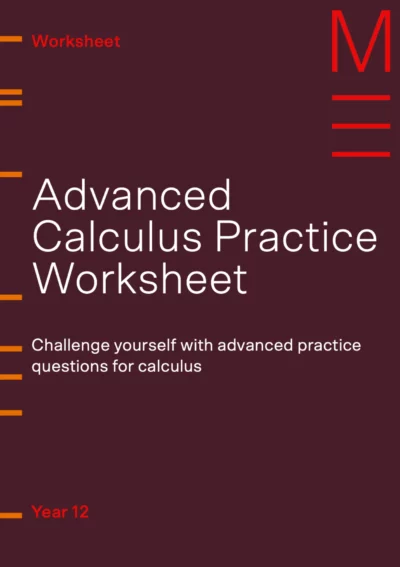Welcome to Matrix Education
To ensure we are showing you the most relevant content, please select your location below.
Select a year to see courses
Learn online or on-campus during the term or school holidays
Learn online or on-campus during the term or school holidays
Learn online or on-campus during the term or school holidays
Learn online or on-campus during the term or school holidays
Learn online or on-campus during the term or school holidays
Learn online or on-campus during the term or school holidays
Learn online or on-campus during the term or school holidays
Get HSC Trial exam ready in just a week
Get HSC exam ready in just a week
Select a year to see available courses
Science guides to help you get ahead
Science guides to help you get ahead

Struggling with Year 11 Calculus? In this Guide, we’re going to give you the rundown on what you need to know to ace Calculus and Year 11 Maths Advanced. We explain the concepts and then give you some examples to work through so you can track your progress.
Calculus plays an important role in building the foundation for later topics such as tangents and exponential growth and decay.
It is also an essential part in understanding the motions of a particle in the real world.
A worksheet to test your knowledge. Fill out your details below to get this resource emailed to you. "*" indicates required fields
Free Year 11 Maths Calculus Worksheet Download

Free Year 11 Maths Calculus Worksheet Download
NESA dictates that students need to learn the following concepts to demonstrate proficiency in Calculus.
Students should be familiar with limits, function notation and graphing non-linear functions.
The most important concept to understand about differentiation is that the derivative is just a gradient. The same gradient that you learn in Year \(9\) with rise over run.
The only difference is that while in junior high school you’re finding the slope between \(2\) different points on a curve, the derivative tells you the slope at a singular point.
For example, to work out the slope between the \(2\) points above on the parabola \(y = x^2\), we would use rise over to run or our gradient formula to give \(m = \frac{4-0}{2-0}= 2\).
However, this simply gives us the average slope between those \(2\) points which we can see doesn’t correspond to the actual parabola. What if we wanted to find the actual curve of the parabola at a specific point such as \((2,4)\)?
If we were to use our normal gradient formula, it might look like the slope of the curve would be \(m =\frac{4-4}{2-2}=\frac{0}{0}\). This is where our derivative can be used.
What if we used the same concept of rise over run, but instead make it on a super, or infinitely small scale?
That would give us the slope of a curve at a specific point. Imagine we essentially zoom in on the point \([x, f(x)]\):
What we’ve done here is shrunk the size of our “run” to a very small value, which we name \(h\).
Now if we use the same gradient formula for this very small space, we’ll find that \(m = \frac{f(x+h)-f(x)}{x+h-x}\), which we can simplify to \(m = \frac{f(x+h)-f(x)}{h}\).
Now, if we want to find the gradient at the specific point \([x, f(x)]\), we let the value of \(h\) approach \(0\) since the gradient we’re looking for is at a single point. Doing this gives the result:
\(\frac{dy}{dx}=lim_{h→0}\frac{f(x+h)-f(x)}{h}\).
This is what we call the first principles of differentiation.
Over the course of Year \(11\) and Year \(12\), you’ll learn other rules to differentiate different types of functions. One of the simplest ones is the derivative of power functions given by:
\(\frac{d(a\cdot x^n)}{dx}=a \cdot n \cdot x^{n-1}\)
Learn from The HSC Experts with our Year 11 Maths Adv course. Learn more.
Boost your Maths marks!
Expert teachers, weekly quizzes, one-to-one help! Ace your next Maths Adv assessment with Matrix+ Online.
Now that we know how to find the derivative of a function in terms of \(x\), such as \(f(x) = x^2-2x\), let’s consider how we would find the derivative of a composite function not necessarily in simple terms of \(x\), such as \(f(x) = (x+2)^2\).
One way we could do this question would be to expand the bracket and then differentiate normally.
However, we can also utilise chain rule as another method of differentiating \(f(x)\), which is given by:
\(\frac{dy}{dx}=\frac{dy}{du}\times\frac{du}{dx}\)
For our example here, we would let \(u=(x+2)\) and essentially set that as our new variable.
Going by the chain rule, we should have to work out what \(\frac{dy}{du}\) and \(\frac{du}{dx}\) are.
| \begin{align*} \frac{dy}{du}=\frac{d(x+2)^2}{(x+2)} =2 \times (x+2) \end{align*} |
| \begin{align*} \frac{du}{dx}=\frac{d(x+2)}{dx} =1 \end{align*} |
Now we can combine our two results to work out our derivative:
\begin{align*}
\frac{dy}{dx}=\frac{dy}{du}\times \frac{du}{dx} \\
=2\times (x+2) \times 1 \\
=2x+4
\end{align*}
We’ve talked about differentiating simple and composite functions, but what about the product of 2 separate functions?
For example, \(f(x)=(3x^2+4)×(9x-7)\).
Again, we can simply just expand the fraction in this case but later on the functions we get may become much more complicated and it may be easier to apply the product rule:
| \(\frac{d}{dx}[u \times v]=u’v+uv’\). |
Our last differentiation rule we’ll be discussing is the quotient rule, which simply helps us find the derivative of a function that involves division or a fraction.
For example, \(f(x)=\frac{2x+7}{4x^3-7x}\).
The general rule formula for quotient rule is given by:
\(\frac{d}{dx} [\frac{f(x)}{g(x)}]=(f'(x)\cdot g(x) \cdot f(x) \cdot \frac{g'(x)}{[g(x)]^2}\).
Again, for simplicity, some may find it easier to replace \(f(x)\) and \(g(x)\) with \(u\) and \(v\) respectively, giving the same result:
\(\frac{d}{dx}(\frac{u}{v})=\frac{u’v-uv’}{v^2}\).
To understand both stationary points and their nature, let’s first understand what the derivative tells us about the curve’s behaviour:
Condition: A positive derivative.
Example: \(y=x^3\)
By differentiating, we get:
\(\frac{dy}{dx}=3x^2\)
Since the derivative is always positive, the curve must be increasing for all \(x\) values, which is shown in the adjacent graph.
Condition: A negative derivative.
Example: \(y=-x^3\)
By differentiating, we get:
\(\frac{dy}{dx}=-3x^2\)
Since the derivative is always negative, the curve must be decreasing for all \(x\) values.
A stationary point is a point on the curve where it is neither increasing nor decreasing. Mathematically, these are the points that satisfy the following:
Condition: \(Derivative = 0\).
Conditions: \(\frac{dy}{dx}\) is negative to the left of the stationary point. \(\frac{dy}{dx}\) is positive to the right of the stationary point. A minimum stationary point at the origin will look as follows:
Conditions: \(\frac{dy}{dx}\) is positive to the left of the stationary point. \(\frac{dy}{dx}\) is negative to the right of the stationary point. A maximum stationary point at the origin will look as follows:
Consider the following process for finding stationary points and determining their nature:
| Steps | Explanation |
| Step 1 | Differentiate the function. |
| Step 2 | Solve for stationary points by letting the derivative equal zero. |
| Step 3 | \(y\) – coordinate of the stationary point. |
| Step 4 | Stationary point nature. |
Find the stationary points of \(y=x^2+2x\)
Step 1: Differentiate the equation.
\(\frac{dy}{dx}=2x+2\)
Step 2: To solve for stationary points, let \(\frac{dy}{dx}=0\).
\begin{align*}
2x+2=0 \\
2x=-2 \\
x=-1
\end{align*}
Step 3: When finding the \(y\)-coordinate of the stationary point, we substitute the \(x\) value back into the original function.
\begin{align*} y=x^2+2x \\
Let \ x= -1 \\
y=(-1)^2+2(-1)=-1 \end{align*}
Step 4: Determine the nature using a \(\frac{dy}{dx}\) table.
Setup the following table by:
| \(x\) | \(-2\) | \(-1\) | \(0\) |
| \(\frac{dy}{dx}\) | \(2(-2)+2=-2\) | \(0\) | \(2(0)+2=2\) |
Therefore, in this case, we have a minimum at \((-1, -1)\).
| Definition | Notation | |
| Displacement | Change in the position of an object. | \(x\) |
| Velocity | Instantaneous rate of change of displacement with respect to time. | \(v, \frac{dx}{dt}, \dot{x}, x’\) |
| Acceleration | Instantaneous rate of change of velocity with respect to time. | \(a, \frac{dv}{dt}, \ddot{x}, x”\) |
The following graph demonstrates the process in obtaining each motion equation:
Find the velocity and acceleration at \(t=5\) if the displacement equation is \(x=t^3+\frac{3}{t}\).
To find the value of both velocity and acceleration, we must first find their equations.
Since we are given the displacement equation, in order to find the velocity equation, we must differentiate the displacement equation with respect to time.
\(v=\frac{dx}{dt}=3t^2-\frac{3}{t^2}\)
From our velocity equation, to get the acceleration equation, we must differentiate again with respect to time.
\(a=\frac{dv}{dt}=6t+\frac{6}{t^3}\)
Now to find both the acceleration and velocity at \(t=5\), we sub this into both equations.
\begin{align*}
v=3(5)^2 – \frac{3}{5^2} = \frac{1872}{25} \\
a=6(5) + \frac{6}{5^3} = \frac{3756}{125}
\end{align*}
1. Differentiate the following using first principles:
(a) \(y=(x+2)^2\)
(b) \(y=3x+8\)
2. Find the gradient of the curve \(y=3x^3-x^2+8\) at the following points:
(a) \(x = 2\)
(b) \(x = -2\)
3. Differentiate the following functions:
(a) \(y=4x^4-2x^2+9x\)
(b) \(y=(x^2-8)(x-4)\)
(c) \(y=\frac{x^3-8x}{x^2+2}\)
4. Find the stationary points of the curve \(y=8x^2-x^4\) and determine their nature.
5. Given the displacement equation \(x=(t+3)^3+t^5\), find the velocity and acceleration at \(t=3\).
1.
(a) \(y’=2x+4\)
(b) \(y’=3\)
2.
(a) \(32\)
(b) \(40\)
3.
(a) \(16x^3-4x+9\)
(b) \(3x^2-8x-8\)
(c) \(\frac{x^4+14x^2-16}{x^2+2}^2\)
4.
(a) Maximum: \((-2, 48), (2, 48)\)
(b) Minimum: \((0, 0)\)
5.
(a) \(Velocity = 513\)
(b) \(Acceleration = 576\)

Level up your skills in calculus by taking on these challenging problems!

Fill out your details below to get this resource emailed to you.
"*" indicates required fields
© Matrix Education and www.matrix.edu.au, 2025. Unauthorised use and/or duplication of this material without express and written permission from this site’s author and/or owner is strictly prohibited. Excerpts and links may be used, provided that full and clear credit is given to Matrix Education and www.matrix.edu.au with appropriate and specific direction to the original content.